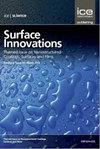摩擦学:表面粗糙度、摩擦和磨损的机器学习算法和数据拓扑方法
IF 3.5
4区 材料科学
Q3 CHEMISTRY, PHYSICAL
引用次数: 5
摘要
摩擦和磨损是非常常见的现象,几乎无处不在。然而,从基本物理原理很难预测摩擦学(即与摩擦和磨损相关的)结构-性能关系。因此,摩擦学仍然是一门数据驱动的学科,主要是经验学科。随着新的机器学习(ML)和人工智能(AI)方法的出现,在摩擦学数据中建立新的相关性以更好地预测和控制新型材料的摩擦学行为成为可能。因此,摩擦学与数据科学相结合,出现了摩擦学信息学的新领域。我们回顾了用于建立金属合金和复合材料结构、摩擦学试验条件、摩擦和磨损之间相关性的ML算法。我们还讨论了表面粗糙度分析的新方法,包括多维数据空间中的数据拓扑概念,用于宏观和纳米级粗糙度。还考虑了其他摩擦信息学方法。本文章由计算机程序翻译,如有差异,请以英文原文为准。
Triboinformatics: Machine Learning algorithms and Data Topology methods for surface roughness, friction, and wear
Friction and wear are very common phenomena found virtually everywhere. However, it is very difficult to predict the tribological (i.e., related to friction and wear) structure-properties relationships from the fundamental physical principles. Consequently, tribology remains a data-driven, mostly empirical discipline. With the advent of new Machine Learning (ML) and Artificial Intelligence (AI) methods, it becomes possible to establish new correlations in tribological data to better predict and control the tribological behavior of novel materials. Hence the new area of triboinformatics has emerged combining tribology with Data Science. We review ML algorithms used to establish correlations between the structure of metallic alloys and composite materials, tribological test conditions, friction, and wear. We also discuss novel methods of surface roughness analysis involving the concept of data topology in multi-dimensional data space, as applied to the macro- and nanoscale roughness. Other triboinformatic approaches are considered as well.
求助全文
通过发布文献求助,成功后即可免费获取论文全文。
去求助
来源期刊

Surface Innovations
CHEMISTRY, PHYSICALMATERIALS SCIENCE, COAT-MATERIALS SCIENCE, COATINGS & FILMS
CiteScore
5.80
自引率
22.90%
发文量
66
期刊介绍:
The material innovations on surfaces, combined with understanding and manipulation of physics and chemistry of functional surfaces and coatings, have exploded in the past decade at an incredibly rapid pace.
Superhydrophobicity, superhydrophlicity, self-cleaning, self-healing, anti-fouling, anti-bacterial, etc., have become important fundamental topics of surface science research community driven by curiosity of physics, chemistry, and biology of interaction phenomenon at surfaces and their enormous potential in practical applications. Materials having controlled-functionality surfaces and coatings are important to the manufacturing of new products for environmental control, liquid manipulation, nanotechnological advances, biomedical engineering, pharmacy, biotechnology, and many others, and are part of the most promising technological innovations of the twenty-first century.
 求助内容:
求助内容: 应助结果提醒方式:
应助结果提醒方式:


